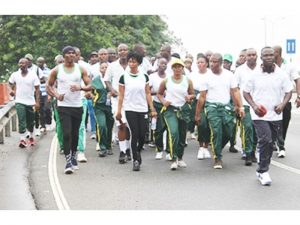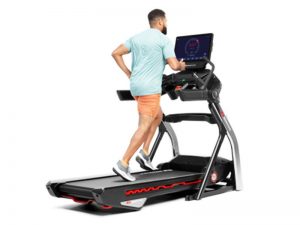Recently the Ghanaian Times published that 24,009 new cases of cancer occur annually in Ghana. Out of the number, 15,802 people lose their lives, most of them victims of breast, liver, cervix and prostate cancers.
What is the way forward?
A recent scientific paper by Papadopetraki et al.(2022)demonstrate that physical exercise lowers cancer risk by 40%. Imagine a pharmaceutical drug that would reduce cancer risk by 40%? That would instantaneously be a trillion-dollar drug. Can you believe that? Just one behavioral change can lower cancer risk by a whopping 40%. The same scientific paper found that physical exercise can be a therapeutic agent for those battling with cancer.
Practical Suggestions

Just get moving if being sedentary is your baseline. Everyone has a period where they become less physically active. That’s not a big deal, but get moving today. Brisk walking at least three hours a week (no less) on pavement or a treadmill works. Brisk walking is defined as walking 3.0 to 4.0 miles per hour (mph) – somewhere between a regular walk and a jog.The heart rate increases and sweat happen after about five to ten minutes.Do this 30 minutes six times a week according to Dr. Geo Espinoza.

If you’re in a little better shape and want to increase your workout load sensibly, go for up to six hours a week. After six hours a week of moderate to high-intensity exercising, there may be less return from that effort, so there is no need to do more than six hours a week.For prostate cancer patients or those trying to reduce their risk, one type of more intense exercise to do three times a week is High-Intensity Interval Training (HIIT).
Kang et al.(2021) study found that such an exercise routine may slow down or reverse prostate cancer.HIIT would consist of five minutes of warm-up on a treadmill, followed by two minutes of a moderate walk, say 3.0 to 3.5 mph, then a run, somewhere between jog to the fastest you can run for 2-minutes, then back to a brisk walk for 2-minutes. Alternate the 2-minute walk and 2-minute run five to eight times. Do this HIIT routine 3 times a day.
Weight resistance or strength training?
Zaccardi et al. (2021) study also found that everyone benefits from strength training for longevity; the stronger one is physical, the longer one lives. Weight resistance training is essential for all; for men on ADT(Androgen Deprivation Therapy), it is imperative as they need to conserve muscle, keep strong bones and prevent metabolic syndrome – a condition common when testosterone is depleted in the body.On what to use for weight resistance exercises, Dr. Geo Espinoza, a renowned Naturopathic Urologist recommend:
- Bodyweight exercises like push-ups, weights like barbells and kettlebells, and resistant bands work great.He further asserts:do six to twelve repetitions maximum, not more. He explained; this method allows you to keep muscle, stay physically strong and keep body fat down during ADT.He advised against doing no more than 12 repetitions to avoid injuries.
Lastly, if you enjoy any sports activity like tennis or golf, keep at it; just add the recommendations above to your athletic training. Remember, after a prostate cancer diagnosis, Kenfield et al.(2011) study found that men have a 61% lower risk of mortality from the disease. A similar study by Richman et al.(2011) also found that prostate cancer patients have a 57% reduction of recurrence when exercising three hours a week or more.

A strong comparable research by Moore et al.(2016) proved that a solid prescription of physical activity can drastically lower your risk of 13 different types of cancers! The study, published in JAMA Internal Medicine, looked at information from 1.4 million people ages 19 to 98 collected over the course of about 11 years. Researchers from the National Institutes of Health, Harvard University and other leading global research organizations gleaned data on people’s exercise during leisure time (things like brisk walking, swimming and running) and at what intensity. Exercise appeared to be most protective against esophageal cancer (42 percent lower risk), followed by liver cancer (27 percent lower risk) and lung cancer (26 percent lower risk).
Another article by Leah Zerbe(2016) also found that those who exercised the most enjoyed a 23 percent lower risk of kidney cancer, a 22 lower risk of gastric cardia (a type of stomach cancer), a 21 percent lower risk of endometrial cancers, a 20 percent lower risk of myeloid leukemia, a 17 percent lower risk of myeloma, a 16 percent lower risk of colon cancer, a 15 percent lower risk head and neck cancer, a 13 percent lower risk of both rectal and bladder cancers and a 10 percent reduced risk of breast cancer. (The study did find exercise slightly increased the risk of melanoma and a type of slow-growing prostate cancer.)
The rising cases of cancers and moratlity rate is a public health concern. We need to get moving together. We cant fight with sedentary lifestyle. The Moore large study that examined more than 1.4 million people and how exercise impacted their risk of different cancers found that those who exercised the most enjoyed a reduced risk of 13 different cancers, including common cancers like breast, lung and colon cancers, compared to those who lived sedentary lifestyles. Use this as daily inspiration to become more active and your body will thank you.

These huge studies, should inspire doctors to prescribe exercise for the powerful medicine it is — and serve as inspiration for us to all get moving more throughout our days. The point is you don’t need to spend hours a day exercising. One study found people who exercised at a moderate intensity for even shorter bouts of time enjoyed cancer prevention benefits. Because long sessions of cardio weren’t necessary to produce the cancer-protective benefits found in this study
The writer is a Professor of Naturopathic Healthcare, President,Nyarkotey College of Holistic Medicine & Technology (NUCHMT)/African Naturopathic Foundation .E-mail: collegeofholisticmedicine@gmail.com.









